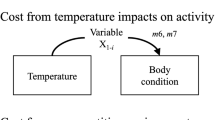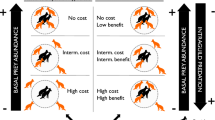Summary
The rate with which resources in an area recover from local exploitation should influence the costs to an inhabitant of sharing it with neighbors. I develop a model which predicts the costs of tolerating conspecific foragers (or the benefits of excluding them) as a function of a predator's rate of harvesting prey and the prey's renewal rate. The predictions are consistent with patterns of social grouping observed in small African carnivores. A generalization of the model considers alternate forms of resource renewal (logistic, constant, or “exponential”) and suggests that not only the average rate of renewal but also the details of its time course should influence animal spacing patterns.
Similar content being viewed by others
References
Altmann SA (1974) Baboons, space, time, and energy. Am Zool 14:221–248
Angelis DL De, Tharp ML (1977) A computer code for the three-dimensional graphing of multiple surfaces: applications to ecology. Oak Ridge National Laboratory, Oak Ridge, Tennessee, 64 pp
bekoff M, Wells MC (1980) The social ecology of coyotes. Sci Am 224(4):130–150
Bowen WD (1978) Social organization of the coyote in relation to prey size. Unpublished Ph.D. thesis, University of British Columbia
Bradbury JL, Vehrencamp SL (1976) Social organization and foraging in Emballonurid bats. II. A model for the determination of group size. Behav Ecol Sociobiol 1:383–404
Bertram BCR (1978) Living in groups: predators and prey. In: Krebs JR, Davies NB (eds) Behavioural Ecology. Sinauer, Sunderland, pp 64–96
Calhoun JB (1963) The social use of space. In: Mayer WV, Gelder RG Van (eds) Physiological mammalogy. Academic Press, New York, pp 1–187
Caraco T, Wolf L (1975) Ecological determinats of group sizes of foraging lions. Am Nat 109:343–352
Charnov EL, Orians GH, Hyatt K (1976) Ecological implications of resource depression. Am Nat 110:247–259
Cody ML (1971) Finch flocks in the Mojave desert. Theor Popul Biol 2:142–158
Cody ML (1974) Optimization in ecology. Science 183:1156–1164
Dill LM (1978) An energy-based model of optimal feeding-territory size. Theor Popul Biol 14:396–429
Gill FB (1978) Proximate costs of competition for nectar. Am Zool 18:753–763
Gill FB, Wolf LL (1977) Nonrandom foraging by sunbirds in a patchy environment. Ecology 58:1284–1296
Gill FB, Wolf LL (1979) Nectar loss by golden-winged sunbirds to competitors. Auk 96:448–461
Gorman ML (1979) Dispersion and foraging of the small Indian mongoose, Herpestes auropunctatus, relative to the evolution of social viverrids. J Zool (Lond) 187:65–73
Goss-Custard JD (1970) Feeding dispersion in some overwintering wading birds. In: Crook JH (ed) Social behavior in birds and mammals. Academic Press, London, pp 3–35
Horn HS (1968) The adaptive significance of colonial nesting in the Brewer's blackbird Euphagus cyanocephalus. Ecology 49:682–694
Jarman P (1974) The social organization of ungulates in relation to their ecology. Behaviour 48:215–267
Kamil AC (1978) Systematic foraging for nectar by the amakihi (Loxops virens). J Comp Psychol 92:388–396
Kemeny JG, Snell JL, Thompson GL (1957) Introduction to finite mathematics. Prentice-Hall, Englewood Cliffs
Kleiman DG, Eisenberg JF (1973) Comparisons of canid and felid social systems from an evolutionary perspective. Anim Behav 21:637–659
Krebs JR (1979) Feeding strategies and their social significance. In: Marler P, Vandenbergh J (eds) Handbook of behavioral neurobiology: Social behavior and communication. Plenum, New York, pp 225–270
Kruud H (1972) The spotted hyaena. University of Chicago Press, Chicago
Kruuk H (1975) Functional aspects of social hunting by carnivores. In: Baerends G, Beer C, Manning A (eds) Function and evolution in behavior. Clarendon Press, Oxford, pp 119–141
Kruuk H (1978) Foraging and spatial organization of the European badger, Meles meles L. Behav Ecol Sociobiol 4:75–89
Lamprecht J (1978) The relationship between food competition and foraging group size in some larger carnivores. Z Tierpsychol 46:337–343
Lamprecht J (1979) Field observations on the behavior and social system of the bat-eared fox Otocyon megalotis Desmarest. Z Tierpsychol 49:260–284
MacArthur RA (1972) Geographical ecology. Harper and Row, New York
MacDonald DW (1978) Observations on the behaviour and ecology of the striped hyaena (Hyaena hyaena) in Israel. Isr J Zool 27:189–198
Mech LD (1970) The wolf Natural History Press, New York
Miller RS (1967) Pattern and process in competition. Adv Ecol Res 4:1–74
Nudds TD (1978) Convergence of group size strategies by mammalian social carnivores. Am Nat 112:957–960
Rood JP (1975) Population dynamics and food habits of the banded mongoose. East Afr Wildl J 13:89–111
Rood J (1978) Dwarf mongoose helpers at the den. Z Tierpsychol 48:277–287
Rood JP, Waser PM (1978) The slender mongoose, Herpestes sanguineus, in the Serengeti. Carnivore 1(3):54–58
Schaller G (1972) The serengeti lion. University of Chicago Press, Chicago
Schaller G, Lowther G (1969) The relevance of carnivore behavior to the study of early homonids. SW J Anthropol 25:307–339
Waser PM (1980) Small nocturnal carnivores: ecological studies in the Serengeti. Afr J Ecol 18:167–185
Wolf LL (1978) Aggressive social organization in nectarivorous birds. Am Zool 18:765–778
Author information
Authors and Affiliations
Rights and permissions
About this article
Cite this article
Waser, P.M. Sociality or territorial defense? The influence of resource renewal. Behav Ecol Sociobiol 8, 231–237 (1981). https://doi.org/10.1007/BF00299835
Received:
Accepted:
Issue Date:
DOI: https://doi.org/10.1007/BF00299835




